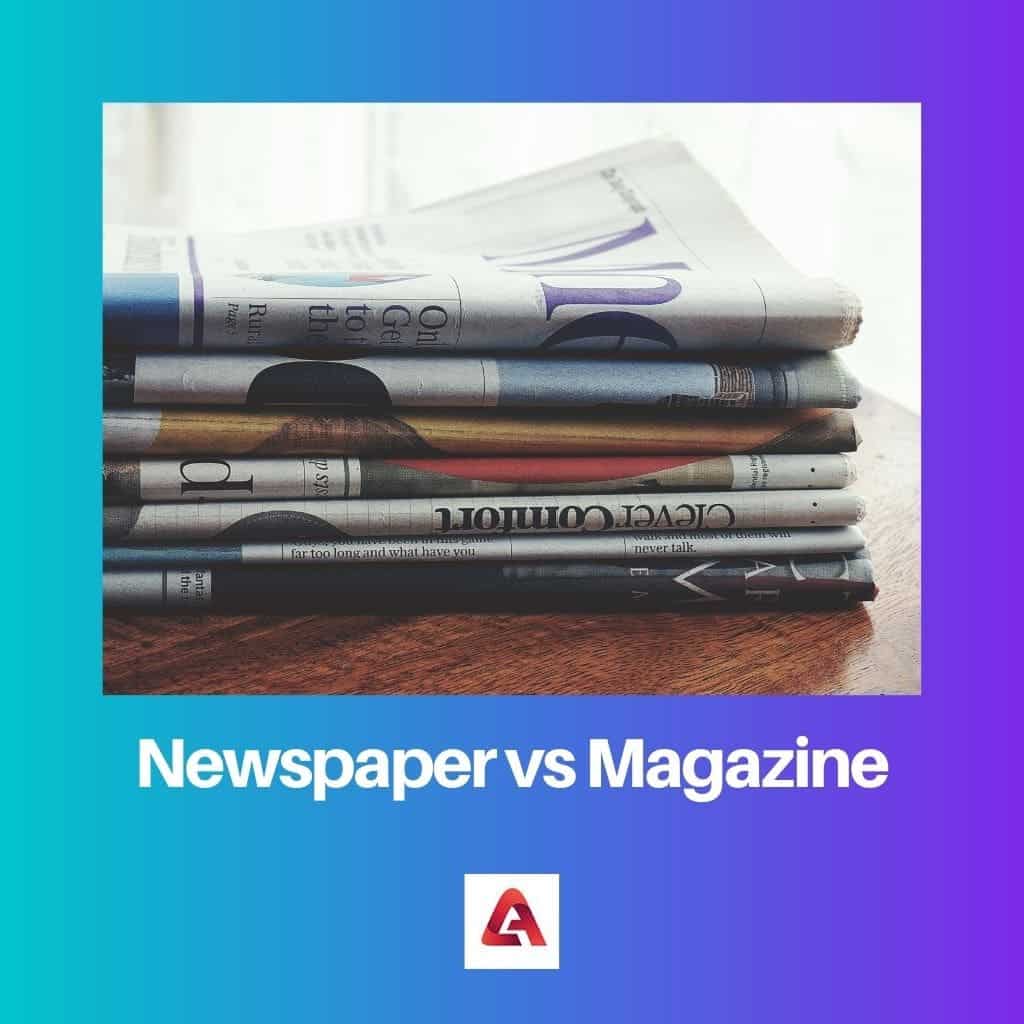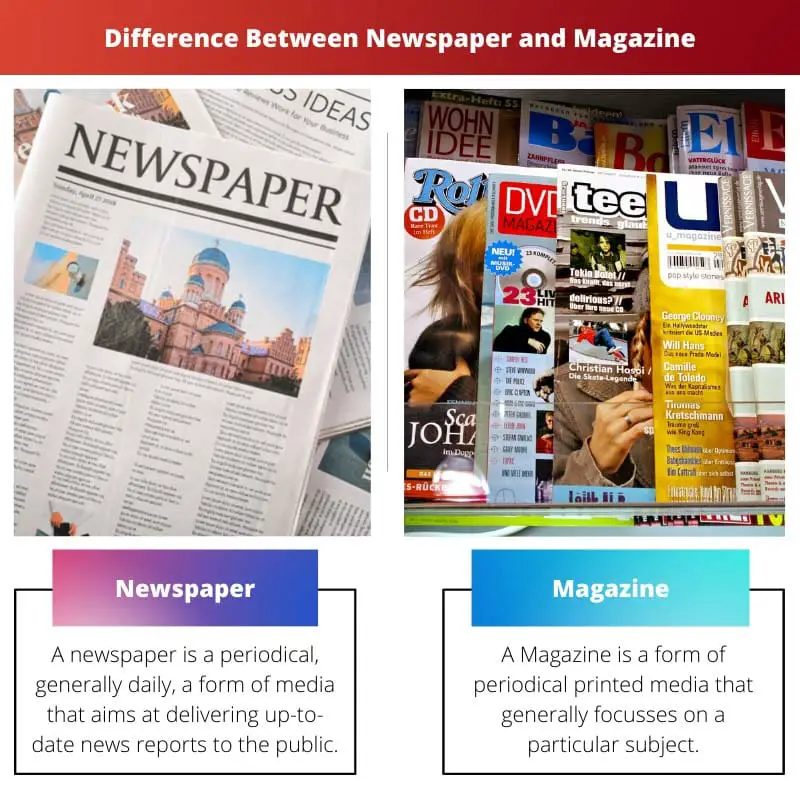Newspapers primarily focus on delivering current news and events, aiming for timely reporting and broad coverage. Magazines, on the other hand, offer in-depth analysis, feature articles, and specialized content, catering to specific interests. While newspapers prioritize immediacy, magazines emphasize depth and exploration of diverse topics.
Key Takeaways
- Newspapers are publications containing news, articles, and commentary on current events, printed on inexpensive paper and published daily or weekly.
- Magazines are periodicals that cover a specific topic or interest, featuring articles, essays, and visuals, published on higher-quality paper and issued weekly, monthly, or quarterly.
- Newspapers focus on timely news and events, while magazines delve into specialized subjects, with more in-depth content and a higher production value.
Newspaper vs Magazine
The difference between newspapers and magazines is that newspapers present recent issues and other information in a formal, brief, and objective matter. At the same time, a magazine focuses on specific subjects and includes articles, interviews, and current issues.

Newspapers follow a simple and formal layout. On the contrary, magazines are targeted at a specific readership; hence, an engrossing arrangement is an essential aspect.
Comparison Table
| Feature | Newspaper | Magazine |
|---|---|---|
| Focus | Current events and news | In-depth analysis, features, and specific topics |
| Publication Frequency | Daily or weekly | Weekly, monthly, or quarterly |
| Target Audience | General public | Specific demographics or interest groups |
| Article Length | Short and concise | Longer articles with more detail |
| Writing Style | Objective and factual | May include analysis, opinion pieces, and interviews |
| Visuals | Primarily text-oriented, with some photos and graphics | More visually appealing with high-quality photos, illustrations, and design |
| Paper Quality | Lower-grade newsprint | Higher quality, glossy paper |
| Price | Relatively inexpensive | More expensive than newspapers |
| Shelf Life | Information becomes outdated quickly | Articles can be relevant for a longer period |
What is Newspaper?
History of Newspapers
Early Origins
The concept of newspapers dates back to ancient civilizations, where handwritten news sheets were distributed. However, the first true newspapers emerged during the 17th century in Europe. Notable publications include “The London Gazette” in 1665 and “Acta Eruditorum” in 1682.
Evolution of Print Media
The 19th century witnessed a significant expansion of newspapers, with advancements in printing technology and the rise of mass literacy. This period saw the establishment of iconic newspapers like “The Times” in London and “The New York Times” in the United States.
Structure of a Newspaper
Front Page
The front page features the most significant and breaking news stories. It includes headlines, photographs, and brief summaries to capture readers’ attention.
Sections and Headings
Newspapers are organized into sections, such as news, sports, business, entertainment, and opinion. Each section contains articles related to its theme, accompanied by appropriate headings.
Editorial and Opinion Pieces
Editorials express the newspaper’s official stance on various issues, while opinion pieces provide a platform for columnists and contributors to share their perspectives.
Functions of Newspapers
Informing the Public
The primary function of newspapers is to inform the public about local, national, and international events. They serve as a reliable source of information, keeping readers updated on current affairs.
Shaping Public Opinion
Newspapers influence public opinion by presenting news, editorials, and columns that shape how readers perceive and interpret events. They play a crucial role in shaping societal attitudes and values.
Promoting Accountability
Journalism holds institutions and individuals accountable by investigating and reporting on issues of public interest. Newspapers act as a watchdog, exposing corruption, injustice, and wrongdoing.
Challenges and Changes in the Newspaper Industry
Digital Transformation
The advent of the internet has revolutionized the newspaper industry. Many traditional newspapers have transitioned to online platforms to adapt to changing reader habits.
Revenue and Sustainability
Newspapers face challenges in generating revenue, with declining print advertising and the rise of free online content. Subscription models and innovative revenue streams are being explored to ensure sustainability.

What is Magazine?
History of Magazines
Early Beginnings
Magazines have a rich history that dates back to the 17th century. The first known magazine, “The Gentleman’s Magazine,” was published in London in 1731 by Edward Cave. Early magazines focused on literary and political content, serving as a platform for intellectual discussions.
Evolution in the 19th Century
The 19th century witnessed a significant expansion of the magazine industry. Advances in printing technology allowed for mass production, leading to the rise of popular magazines catering to diverse audiences. Topics expanded to include fashion, lifestyle, and hobbies, reflecting the changing interests of society.
20th Century and Beyond
The 20th century brought further diversification in magazine content. Specialized magazines emerged, targeting niche markets such as sports, science, and technology. The advent of digital technology in the 21st century transformed the landscape, enabling the rise of online magazines and digital platforms.
Characteristics of Magazines
Visual Appeal
Magazines are known for their visually striking layouts. They use a combination of images, illustrations, and typography to capture the reader’s attention. High-quality photography and graphic design contribute to the overall aesthetic appeal.
Varied Content
Magazines cover a broad spectrum of topics, including but not limited to fashion, beauty, health, lifestyle, travel, technology, and current affairs. This diversity allows publishers to cater to a wide audience with different interests and preferences.
Periodicity
Unlike newspapers, which are daily publications, magazines follow a regular publishing schedule. This periodicity can be weekly, monthly, quarterly, or even annually, providing readers with a consistent source of curated content.
Advertising
Magazines rely on advertising revenue to sustain their operations. Advertisements are strategically placed throughout the publication and contribute to the overall revenue stream. In some cases, magazines may feature advertorials, blending editorial content with promotional material.
Types of Magazines
Consumer Magazines
Consumer magazines target a general audience and cover a wide range of topics, from lifestyle and entertainment to health and travel. Examples include “Vogue,” “National Geographic,” and “Time.”
Trade Magazines
Trade magazines focus on specific industries or professions, providing in-depth information relevant to professionals within those fields. Examples include “The Hollywood Reporter” for the entertainment industry and “Architectural Digest” for architecture and design.
Special Interest Magazines
Special interest magazines cater to niche audiences with a particular passion or hobby. Examples include “Runner’s World” for running enthusiasts and “Wired” for technology enthusiasts.
Impact of Digitalization
Rise of Online Magazines
The digital era has led to the emergence of online magazines, accessible through websites and mobile applications. This shift has allowed for real-time updates, interactive content, and a global reach beyond traditional print boundaries.
Challenges and Opportunities
While digitalization has opened new avenues for magazine publishers, it also poses challenges such as adapting to changing reader habits, addressing online competition, and exploring sustainable revenue models.

Main Differences Between Newspapers and Magazines
- Frequency of Publication:
- Newspapers: Typically published daily or weekly, providing current news and events.
- Magazines: Usually published on a weekly, monthly, or quarterly basis, with a focus on in-depth articles and features.
- Content Focus:
- Newspapers: Primarily focus on current events, news, and timely information.
- Magazines: Cover a broader range of topics, including lifestyle, entertainment, in-depth features, and long-form articles.
- Article Length:
- Newspapers: Feature shorter articles to convey information quickly.
- Magazines: Include longer, more in-depth articles that explore topics in detail.
- Writing Style:
- Newspapers: Emphasize clarity and conciseness, delivering information in a straightforward manner.
- Magazines: Tend to have a more diverse writing style, including creative elements and a focus on storytelling.
- Advertising:
- Newspapers: Often have a higher ratio of news content to advertisements.
- Magazines: Rely more on advertisements to support their publication, with visually appealing layouts.
- Target Audience:
- Newspapers: Aimed at a broad audience interested in current events and general news.
- Magazines: Cater to specific niche markets or interests, appealing to more specialized readerships.
- Layout and Design:
- Newspapers: Have a straightforward and functional layout to accommodate a large volume of news content.
- Magazines: Feature more elaborate designs, with attention to aesthetics, graphics, and visual appeal.
- Distribution:
- Newspapers: Widely distributed, available at newsstands, convenience stores, and through subscriptions.
- Magazines: May have more targeted distribution channels, focusing on specific outlets and subscription services.
- Timeliness:
- Newspapers: Prioritize timely reporting to keep readers informed of the latest news developments.
- Magazines: Can provide more in-depth analysis and features that are not time-sensitive, allowing for a longer shelf life.
- Editorial Voice:
- Newspapers: Tend to maintain an objective and neutral editorial voice.
- Magazines: May adopt a more subjective or specialized editorial tone, reflecting the magazine’s theme or target audience.



